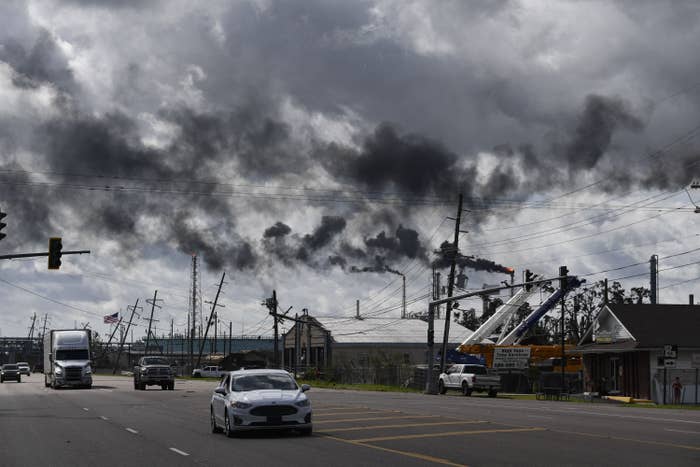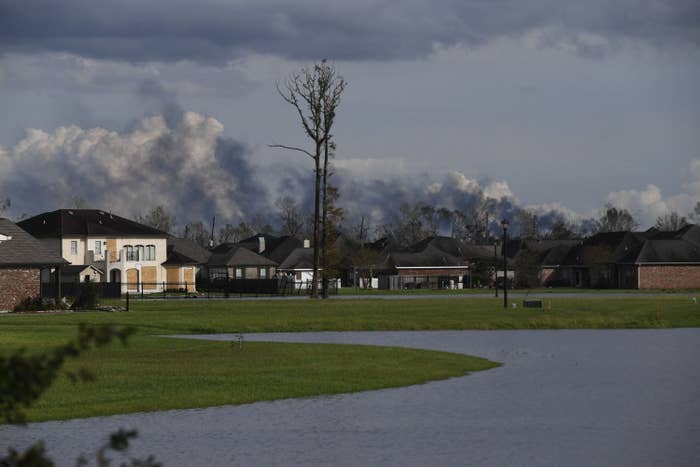ECOCIDE
One Of The Largest US Petrochemical Plants Is Spewing Excessive Smoke After Hurricane Ida Knocked Out Its PowerIndustrial sites often spew dirty gases into the air during emergency shutdowns and restarts, threatening nearby communities with smog and other pollution that can make it hard for people to breathe.
Zahra HirjiBuzzFeed News Reporter
Last updated on September 2, 2021

Patrick T. Fallon / AFP via Getty Images
Vehicles drive past the petrol chemical plant near Highway 61 in Norco, Louisiana, on Aug. 30, 2021, after Hurricane Ida made landfall.
A massive Royal Dutch Shell manufacturing complex in Louisiana’s St. Charles Parish is releasing nonstop plumes of smoke into the air after Hurricane Ida knocked out its power.
Local, state, and federal officials are monitoring the incident.
The plumes of smoke at Shell’s Norco plant are just one of a growing number of sources of industrial pollution slowly coming into view across the Gulf Coast following the Category 4 hurricane’s devastating blow to the region.
Ida washed out roads, flattened homes and businesses, felled trees, and knocked out power for roughly 1 million people, including the entire city of New Orleans. At least seven people died in the region due to the storm.
At this point, Shell is not saying much about the problems plaguing the Norco facility, one of the largest petrochemical plants in the country.
In response to questions from BuzzFeed News, an oil company spokesperson declined to say what gases are being released or what amount of emissions have already gone into the air.
The company also did not share a timeline for when the plumes of black smoke would stop.
“While the site remains safe and secure, we are experiencing elevated flaring,” Curtis Smith, a Shell spokesperson, told BuzzFeed News in an email. “We expect this to continue until power is restored.”
When it’s up and running, Shell’s combined refinery and chemical plant in Norco processes about 250,000 barrels of crude oil and 170,000 barrels of gasoline a day, in addition to generating billions of pounds of ethylene, propylene, and other chemicals.
Like other refineries and industrial sites along the Gulf Coast, Shell shut down the plant ahead of Ida’s landfall.

Patrick T. Fallon / AFP via Getty Images
Smoke from flaring operations a refinery in Norco, Louisiana, drifts on the horizon with clouds as homes stand in a neighborhood that experienced flooding in LaPlace, Louisiana, on Aug. 30, 2021, in the aftermath of Hurricane Ida.
Industrial sites often spew dirty gases into the air during emergency shutdowns and restarts, threatening nearby communities with smog and other pollution that can make it hard for people to breathe.
Back in 2017, Hurricane Harvey led to Texas chemical and petroleum plants releasing a year’s worth of pollution in a matter of days and weeks, according to a BuzzFeed News analysis.
According to Shell’s Norco permit, some flaring in emergency situations is allowed, but it's unclear whether the current emission levels exceed what’s allowable under the permit.
“Shell Norco is flaring,” Gregory Langley, press secretary of Louisiana’s Department of Environmental Quality, told BuzzFeed News in an email. “When there is an emergency condition, they are allowed to do this under their permit.”
That being said, Langley added, “The flares at Shell Norco are large and produce some smoke.”
Starting Thursday, Louisiana’s environmental officials will monitor Norco’s air quality using what’s called a Mobile Air Monitoring Laboratory.
The Environmental Protection Agency is also sending a special plane to help monitor local air emissions in Norco, agency press secretary Nick Conger told BuzzFeed News in an email. EPA has received reports of the facility flaring four types of noxious gas: butadiene, benzene, hydrogen sulfide, and hydrogen, Conger added.
“Excessive smoke seen in the community is a result of a lack of electricity” at the plant, EPA officials wrote in an incident summary posted online Wednesday afternoon.
They noted that Shell is conducting its own air monitoring along the Norco fence line and in the surrounding community, reporting that information to emergency officials in St. Charles Parish, and company engineers “are looking at all options to try to reduce emissions to flare.”
St. Charles Parish officials did not immediately respond to questions from BuzzFeed News. Shell also declined to provide information about its air monitoring results to BuzzFeed News.
Norco residents say the current flaring levels aren’t normal.
“This is bad,” Norco resident Peter Anderson told DeSmog. “I have never seen this many flares.”
Beyond Norco, Shell is still assessing whether Ida damaged a chemical plant in Geismar, Louisiana, as well as any of the company’s floating platforms and other infrastructure used for extracting fossil fuels offshore in the Gulf of Mexico.
Ongoing power outages, widespread storm debris, and impassable roads are complicating the ability of companies and government officials to quickly identify environmental impacts, such as emission releases and spills, triggered by the storm.
At least 138 major industrial sites are located in parishes hit hard by Ida, according to the New York Times.
As of Wednesday afternoon, the EPA had received 28 reports of possible spills and pollution events in places hit by Ida, including 17 possible air pollution incidents. None of them have so far required the EPA to do on-the-ground assessments.
Meanwhile, the Associated Press reported on Wednesday that there’s a mileslong black slick of oil near an oil rig in Gulf waters. The spill was identified using aerial imagery.
UPDATE
September 2, 2021
This story has been updated to include a response from the Environmental Protection Agency, noting that officials have received reports detailing how four types of gases are being flared at the Norco plant and how the agency is deploying a plane to monitor local air emissions.
Feds responding to reports of oil, chemical spills after Ida
NOT CLEANING UP JUST LOOKING
By MICHAEL BIESECKER

This image provided by NOAA taken Tuesday, Aug. 31, 2021 and reviewed by The Associated Press shows oil slicks at the flooded Phillips 66 Alliance Refinery in Belle Chasse, La. State and federal regulators responded to the spill site after AP provided the photos of the spill Wednesday and the company acknowledged a "sheen of unknown origin" at its flooded refinery. (NOAA via AP)
WASHINGTON (AP) — Federal and state agencies say they are responding to reports of oil and chemical spills resulting from Hurricane Ida following the publication of aerial photos by The Associated Press.
Environmental Protection Agency spokesman Nick Conger said Thursday that a special aircraft carrying photographic and chemical detection equipment was dispatched from Texas to Louisiana to fly over the area hard hit by the Category 4 storm, including a Phillips 66 refinery along the Mississippi River where the AP first reported an apparent oil spill on Wednesday.
Coast Guard spokesman Petty Officer 3rd Class Gabriel Wisdom said Thursday that its aircraft has also flown over the refinery, as well as to the Gulf of Mexico. The AP published photos of a miles-long brownish-black slick in the waters south of Port Fourchon, Louisiana.



Photos captured by National Oceanic and Atmospheric Administration aircraft Tuesday, Aug. 31, 2021 and reviewed by The Associated Press show a miles long black slick floating in the Gulf of Mexico near a large rig marked with the name Enterprise Offshore Drilling. The company, based in Houston, did not immediately respond to requests for comment by phone or email on Wednesday. EPA officials said Wednesday hey were unaware of any leak requiring a federal response. (NOAA via AP)
The AP first reported the possible spills Wednesday after reviewing aerial images of the disaster zone taken by the National Oceanic and Atmospheric Administration. Ida made landfall Sunday, its eyewall carving through Louisiana with 150 mph winds and a storm surge so powerful it temporarily reversed the flow of the mighty Mississippi.
The NOAA photos showed a black and brown slick floating near a large rig with the name Enterprise Offshore Drilling painted on its helipad. The company, based in Houston, said Thursday that its Enterprise 205 rig was safely secured and evacuated prior to the storm’s arrival and that it did not suffer any damage.
“Enterprise personnel arrived back at the facility on September 1 and confirmed the integrity of all systems and that no environmental discharges occurred from our facility,” the company said in a statement.
Sandy Day, spokesperson for the U.S. Bureau of Safety and Environmental Enforcement, which regulates oil rigs, confirmed it had received a report Wednesday about which the oil spill the AP had published photos. But the location was inside state waters, rather than the federal jurisdiction farther offshore.
Patrick Courreges, spokesman for the Louisiana Department of Natural Resources, said his agency had no way to physically investigate the spill.
“It’s going to be awhile for us before we can make our way out there,” Courreges said Thursday. ”We don’t have planes, helicopters or Gulf-seaworthy boats.”
Aerial photos taken by an NOAA aircraft Tuesday also showed significant flooding to the massive Phillips 66 Alliance Refinery in Belle Chasse, Louisiana. In some sections of the refinery, a rainbow sheen and black streaks were visible on the water leading toward the river.
In statements issued Monday and Tuesday, Phillips 66 said “some water” was inside the refinery, but did not respond to questions about environmental hazards.
Only after the AP sent the company photos Wednesday showing extensive flooding and what appeared to be petroleum in the water, the company confirmed it had “discovered a sheen of unknown origin in some flooded areas of Alliance Refinery.”
“At this time, the sheen appears to be secured and contained within refinery grounds,” Phillips 66 spokesman Bernardo Fallas said Wednesday evening, three days after the hurricane blew through. “Clean-up crews are on site. The incident was reported to the appropriate regulatory agencies upon discovery.”
Though Fallas characterized the spill as a “sheen of unknown origin,” the report Phillips 66 made to Louisiana regulators Wednesday called it “heavy oil in floodwater,” according to a state call log provided to the AP. The log also contained a call from an oyster harvester concerned that water contamination from the refinery was fouling environmentally sensitive beds downriver.
Louisiana Department of Environmental Quality spokesman Greg Langley said Wednesday that a state assessment team was sent to the refinery and observed an on-site oil spill being addressed with booms and absorbent pads. A levee meant to protect the plant had breached, allowing floodwaters to flow in during the storm and then back out as the surge receded.
Langley said there was no estimate available for how much oil might have spilled from the refinery.
Louisiana regulators were tracking about 100 reports of chemical and petroleum spills statewide as of Wednesday. The reports ranged from sunken boats leaking diesel to overturned fuel tanks and flooded oil pipelines, according to the call log. Several chemical manufacturers also reported venting or flaring off toxic chemicals due to losing electricity.
Stephanie Morris, spokesperson for the Louisiana Oil Spill Coordinator’s Office, said that four days after Ida hit, state regulators were still in the very early stages of responding to the environmental hazards spawned by the storm. She said a state aircraft had been flying over the affected area, focusing more on identifying ongoing threats than quantifying what had already leaked into the water and air.
“We’re in what we call the rapid assessment phase, because we are trying to assess it from the air,” Morris said. “We’re just getting a sense of what’s out there and locations. We don’t have a sense yet of what the sources of sheens might be or volumes.”
___
Follow AP Investigative Reporter Michael Biesecker at http://twitter.com/mbieseck
___
Contact AP’s global investigative team at Investigative@ap.org.
No comments:
Post a Comment